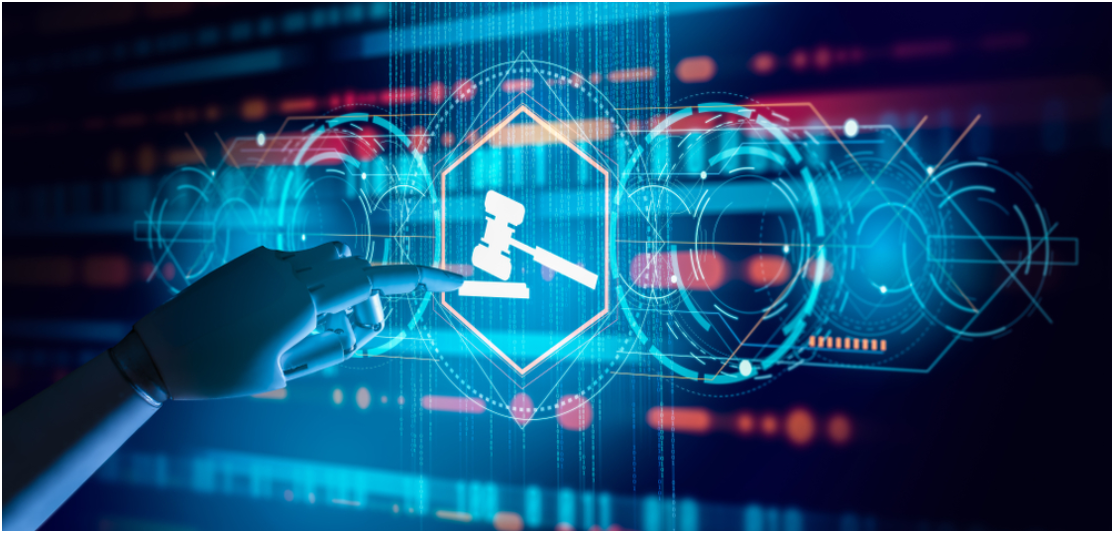
SUPACE – Sowing the Seeds of India’s ‘Futuristic Judiciary’
On April 6, 2021, the Supreme Court of India launched India’s first AI-driven research portal — SUPACE — Supreme Court Portal for Assistance in Court’s Efficiency. It was launched by the former Chief Justice of India, S.A. Bobde, in presence of Justice Nageswara Rao. Through this portal, the Supreme Court intends to leverage machine learning to deal with the amount of data received in the filing of cases.
This AI-powered workflow of SUPACE has four parts: file previews which typically browse through all the files, a chatbot that gives a quick overview of the case, and then comes the logic gate which provides proper chronology and judgement to the case which will be embedded with the notebook with voice dictation which can be used to prepare notes on this comprehensive drafting tool. The combination of this workflow will be a perfect blend of human intelligence and machine learning.

What can AI do for the administration of justice, and what does that require?
Complexity reduction is at the heart of artificial intelligence, irrespective of subject matter. Two main objectives of SUPACE are administrative efficiency and augmenting decision-making processes, as the focal points for AI usage.
The AI spectrum in India can include tools for intelligent analytics and research, and even computational tools (and predictive justice in the longer run). For contract management, AI can review contracts more quickly, organize large-scale contract data more easily, help in contract negotiations, and increase the volume of contracts it can negotiate and execute. AI in the judiciary solely works on Predictive justice tools which are perhaps the most advanced deployment of intelligent machines within the formal justice system and aim to limit arbitrariness and increase sources that will help in human decision-making and judgement within the larger justice system.
Predicting systems in AI also have the potential to analyze the available legal data and make predictions of the legal outcomes out of it, even better than humans can. But the question arises whether AI in the coming days may take over human decision-making.
The former CJI, S.A. Bobde, himself cleared that, “it would be disastrous to let AI do the decision making on cases involving human problems where human discussion is of greatest import, but pointed out that sufficient care has been taken to ensure that AI only collects all relevant facts and the law and makes it available to Judges on their fingertips but without usurping decision making.”
This AI system will be the ray of hope for millions of unfortunate victims languishing in jails without even facing a single day of trial because of an unsustainable process of judicial decision-making.
Short term and long term challenges of the system
Through the use of text boxes, and by selecting global examples, AI in judicial administration has encountered several challenges so far. The short-term challenges include transparency and cybersecurity issues. Lack of transparency in an AI application reduces the ability of human users to make fully informed decisions. Lack of transparency and uncertain human responsibility undermines the ability of oversight and remedial mechanisms to ensure justice and fairness.
While the long-term challenges include the emendation of the system at a general interval of time. Standard policy protocols should be formulated to carry on efficient use of SUPACE which it may face in future revisions. Keeping the constitutional role of the judiciary in mind, the system expects necessary changes in checks and balances carried on by the Supreme Court over the other two organs of the state. Considering the novelty of this system in India, the judicial system of the country can learn from the experiences of implementation of similar systems globally.
Learnings from the experience of other countries in this space
As the development of AI is still evolving, it has been used extensively across the globe in different aspects to serve justice to society. In Singapore, a speech translation system has been deployed by courts. The tool utilizes neural networks trained with language models and domain-specific terms to transcribe court hearings in real-time, thus, allowing judges and parties to review oral testimonies in court instantaneously. USA’s COMPAS or Correctional Offender Management Profiling for Alternative Sanctions has been used to examine recidivism risk and thus, inform parole and sentencing decisions.
AI has been also used in Estonia to adjudicate small claims through a robot judge, in China, Russia, and Mexico to provide legal advice and approve pensions. But since AI relies on having a vast database of past cases to then predict judgments for future cases, AI judges would recreate past mistakes and implicit prejudices of past cases overseen by humans into perpetuity. AI cannot adapt flexibly with the social mores of the time or recalibrate based on past errors. And when the courts become social barometers, the judges should not be informed only of the past.
Relevance of AI in local judicial administration: Based on global case studies
In India, the preparatory practice in the use of AI has already been launched. In 2020, the Supreme Court developed software called SCI-Interact to make its 17 benches paperless. Other initiatives like LIMBS, E-Courts, etc. have also been developed. It is a one-of-a-kind solution that is completely customizable and behaves uniquely like its user. The AI within it adapts and adopts user behavior based on incremental usage of the platform. This is one of the first examples of mass customization in the world.
Some global best practices can be replicated in the Indian context. AI systems like Brazilian Victor can play a significant role in Indian state tribunals like ITAT in docket management and decision-making. Also, this system can be employed in courts which will possess reading speeds of 1 million characters per second. A similar system can be used to read and extract all relevant facts, compute tax effects and assist in infinite ways to propel the pace of decision-making.
By bringing these reforms, India can expect brisker justice and if that happens, the clogging of cases in courts could end. This will particularly benefit those with fewer resources, poor citizens, small and medium enterprises, low-cost contractual breaches, property disputes, etc. But, the transition to reading and engaging with e-documents from paper ones, for instance, may not be as easy as planned. Referring to multiple pages across varying courts will need the judges to adapt and learn new skills too. This may also bring considerable costs on the judiciary to implement in all the lower courts or tribunals.
But along with that intention of the change being clear, the benefits are likely to override these costs and inconveniences in the coming future.
Also read: Tuberculosis: The Clock is Ticking, Can India Beat the Global Target?
